Презентация magnetic properties

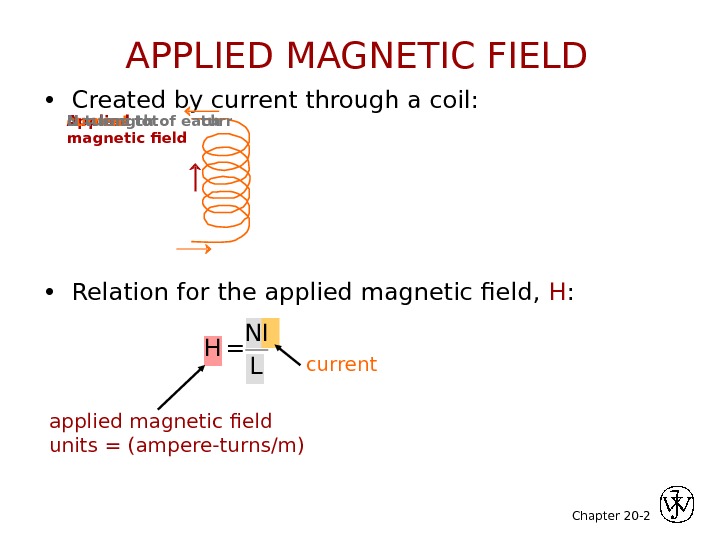
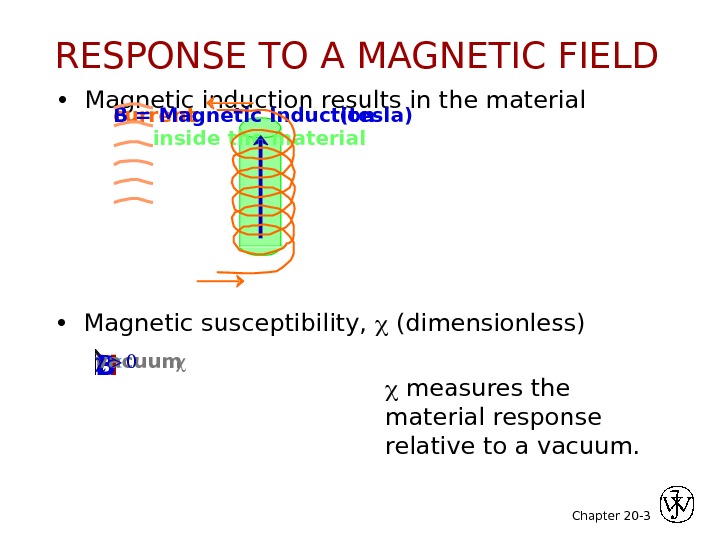

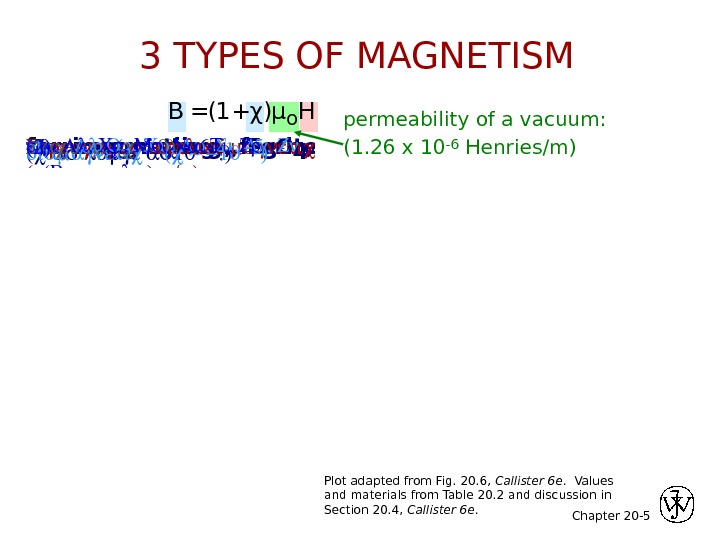
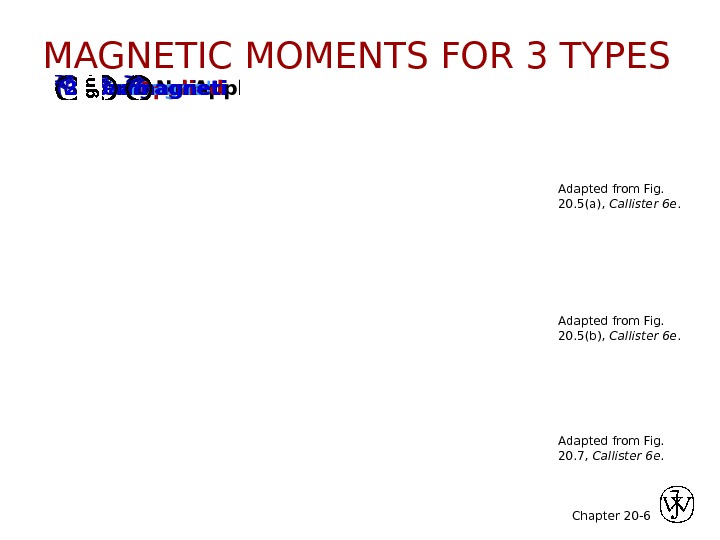
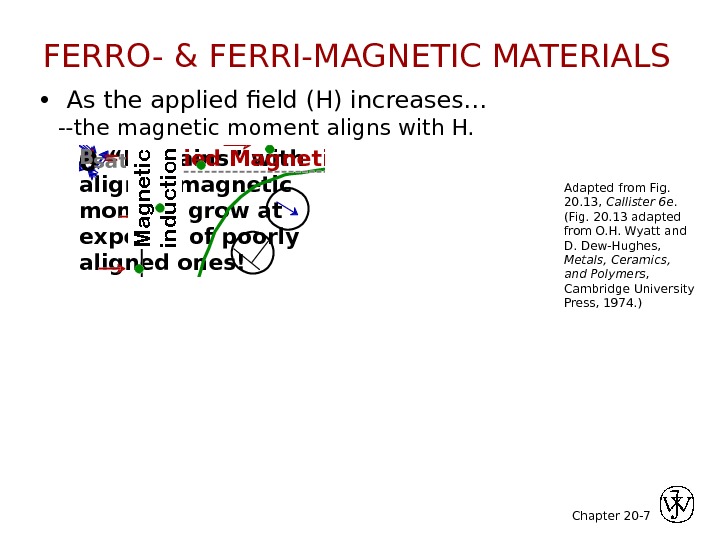
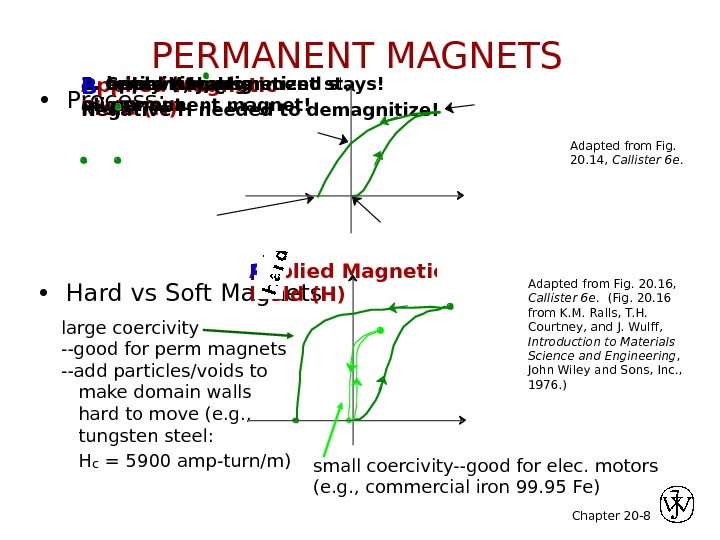
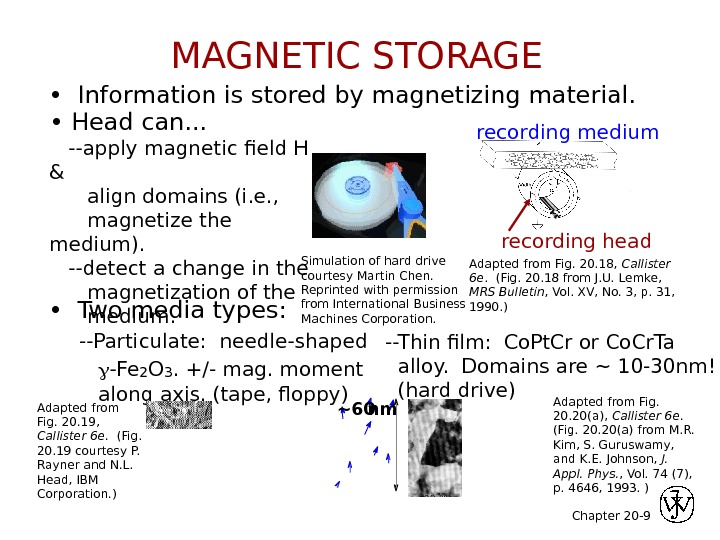
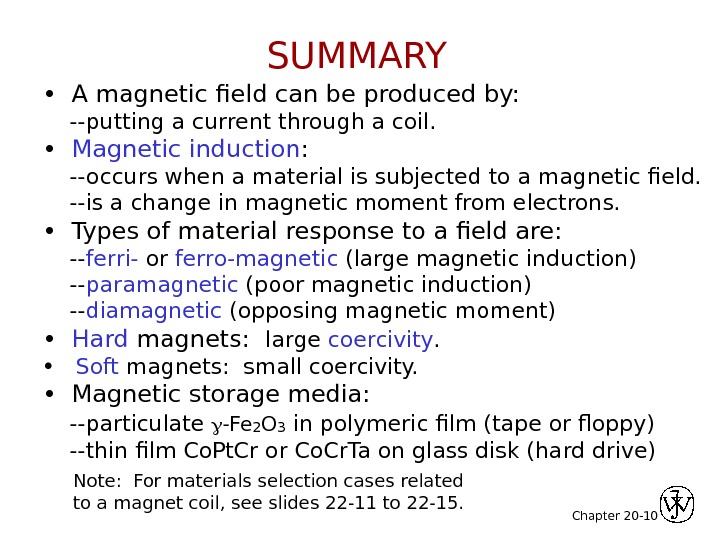
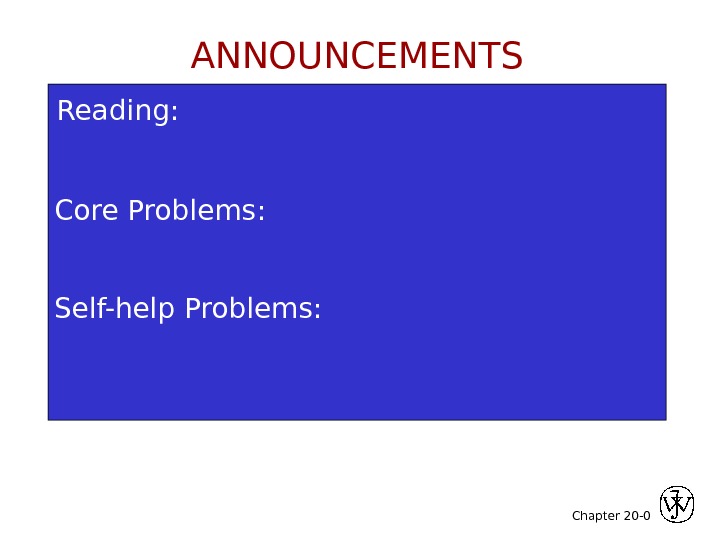
- Размер: 651 Кб
- Количество слайдов: 11
Описание презентации Презентация magnetic properties по слайдам
 Chapter 20 -ISSUES TO ADDRESS. . . • How do we measure magnetic properties ? 1 • What are the atomic reasons for magnetism? • Materials design for magnetic storage. • How are magnetic material classified? CHAPTER 20: MAGNETIC PROPERTIES
Chapter 20 -ISSUES TO ADDRESS. . . • How do we measure magnetic properties ? 1 • What are the atomic reasons for magnetism? • Materials design for magnetic storage. • How are magnetic material classified? CHAPTER 20: MAGNETIC PROPERTIES
 Chapter 20 — 2 • Created by current through a coil: A pplied magnetic field Hcurrent IN turns total. L = length of each turn • Relation for the applied magnetic field, H : H= NI L applied magnetic field units = (ampere-turns/m) current. APPLIED MAGNETIC FIEL
Chapter 20 — 2 • Created by current through a coil: A pplied magnetic field Hcurrent IN turns total. L = length of each turn • Relation for the applied magnetic field, H : H= NI L applied magnetic field units = (ampere-turns/m) current. APPLIED MAGNETIC FIEL
 Chapter 20 — 3 • Magnetic induction results in the material current IB = Magnetic Induction (tesla) inside the material • Magnetic susceptibility, (dimensionless) HBvacuum measures the material response relative to a vacuum. RESPONSE TO A MAGNETIC FIEL
Chapter 20 — 3 • Magnetic induction results in the material current IB = Magnetic Induction (tesla) inside the material • Magnetic susceptibility, (dimensionless) HBvacuum measures the material response relative to a vacuum. RESPONSE TO A MAGNETIC FIEL
 Chapter 20 — 4 • Measures the response of electrons to a magnetic field. • Electrons produce magnetic moments: magnetic momentselectronnucleuselectronspin • Net magnetic moment: —sum of moments from all electrons. • Three types of response. . . Adapted from Fig. 20. 4, Callister 6 e. MAGNETIC SUSCEPTIBILITY
Chapter 20 — 4 • Measures the response of electrons to a magnetic field. • Electrons produce magnetic moments: magnetic momentselectronnucleuselectronspin • Net magnetic moment: —sum of moments from all electrons. • Three types of response. . . Adapted from Fig. 20. 4, Callister 6 e. MAGNETIC SUSCEPTIBILITY
 Chapter 20 — 5 B=(1+χ)μo. Hpermeability of a vacuum: (1. 26 x 10 -6 Henries/m) Plot adapted from Fig. 20. 6, Callister 6 e. Values and materials from Table 20. 2 and discussion in Section 20. 4, Callister 6 e. 3 TYPES OF MAGNETISM ferromagnetic e. g. , Fe 3 O 4 , Ni. Fe 2 O 4 ferrimagnetic e. g. , ferrite(
Chapter 20 — 5 B=(1+χ)μo. Hpermeability of a vacuum: (1. 26 x 10 -6 Henries/m) Plot adapted from Fig. 20. 6, Callister 6 e. Values and materials from Table 20. 2 and discussion in Section 20. 4, Callister 6 e. 3 TYPES OF MAGNETISM ferromagnetic e. g. , Fe 3 O 4 , Ni. Fe 2 O 4 ferrimagnetic e. g. , ferrite(
 Chapter 20 — 6 ferrimagnetic No Applied Magnetic Field (H = 0) Applied Magnetic Field (H) (1) diamagnetic none opposing (3) ferromagnetic aligned (2) paramagnetic random aligned Adapted from Fig. 20. 5(a), Callister 6 e. Adapted from Fig. 20. 5(b), Callister 6 e. Adapted from Fig. 20. 7, Callister 6 e. MAGNETIC MOMENTS FOR 3 TYPES
Chapter 20 — 6 ferrimagnetic No Applied Magnetic Field (H = 0) Applied Magnetic Field (H) (1) diamagnetic none opposing (3) ferromagnetic aligned (2) paramagnetic random aligned Adapted from Fig. 20. 5(a), Callister 6 e. Adapted from Fig. 20. 5(b), Callister 6 e. Adapted from Fig. 20. 7, Callister 6 e. MAGNETIC MOMENTS FOR 3 TYPES
 Chapter 20 — 7 • As the applied field (H) increases. . . —the magnetic moment aligns with H. • “Domains” with aligned magnetic moment grow at expense of poorly aligned ones! Applied Magnetic Field (H) H H H = 0 Magnetic induction (B) 0 B sat Adapted from Fig. 20. 13, Callister 6 e. (Fig. 20. 13 adapted from O. H. Wyatt and D. Dew-Hughes, Metals, Ceramics, and Polymers , Cambridge University Press, 1974. )FERRO- & FERRI-MAGNETIC MATERIALS
Chapter 20 — 7 • As the applied field (H) increases. . . —the magnetic moment aligns with H. • “Domains” with aligned magnetic moment grow at expense of poorly aligned ones! Applied Magnetic Field (H) H H H = 0 Magnetic induction (B) 0 B sat Adapted from Fig. 20. 13, Callister 6 e. (Fig. 20. 13 adapted from O. H. Wyatt and D. Dew-Hughes, Metals, Ceramics, and Polymers , Cambridge University Press, 1974. )FERRO- & FERRI-MAGNETIC MATERIALS
 Chapter 20 -large coercivity —good for perm magnets —add particles/voids to make domain walls hard to move (e. g. , tungsten steel: H c = 5900 amp-turn/m) 8 • Process: • Hard vs Soft Magnets Applied Magnetic Field (H) 4. Coercivity, H c : Negative H needed to demagnitize! 1. initial (unmagnetized state) 2. apply H, cause alignment 3. remove H, alignment stays! -> permanent magnet! B Applied Magnetic Field (H) B Hard Soft Hard small coercivity—good for elec. motors (e. g. , commercial iron 99. 95 Fe) Adapted from Fig. 20. 14, Callister 6 e. Adapted from Fig. 20. 16, Callister 6 e. (Fig. 20. 16 from K. M. Ralls, T. H. Courtney, and J. Wulff, Introduction to Materials Science and Engineering , John Wiley and Sons, Inc. , 1976. ) PERMANENT MAGNETS
Chapter 20 -large coercivity —good for perm magnets —add particles/voids to make domain walls hard to move (e. g. , tungsten steel: H c = 5900 amp-turn/m) 8 • Process: • Hard vs Soft Magnets Applied Magnetic Field (H) 4. Coercivity, H c : Negative H needed to demagnitize! 1. initial (unmagnetized state) 2. apply H, cause alignment 3. remove H, alignment stays! -> permanent magnet! B Applied Magnetic Field (H) B Hard Soft Hard small coercivity—good for elec. motors (e. g. , commercial iron 99. 95 Fe) Adapted from Fig. 20. 14, Callister 6 e. Adapted from Fig. 20. 16, Callister 6 e. (Fig. 20. 16 from K. M. Ralls, T. H. Courtney, and J. Wulff, Introduction to Materials Science and Engineering , John Wiley and Sons, Inc. , 1976. ) PERMANENT MAGNETS
 Chapter 20 — 9 • Information is stored by magnetizing material. recording headrecording medium Simulation of hard drive courtesy Martin Chen. Reprinted with permission from International Business Machines Corporation. • Head can. . . —apply magnetic field H & align domains (i. e. , magnetize the medium). —detect a change in the magnetization of the medium. • Two media types: —Particulate: needle-shaped -Fe 2 O 3. +/- mag. moment along axis. (tape, floppy) ~2. 5 —Thin film: Co. Pt. Cr or Co. Cr. Ta alloy. Domains are ~ 10 -30 nm! (hard drive) Adapted from Fig. 20. 18, Callister 6 e. (Fig. 20. 18 from J. U. Lemke, MRS Bulletin , Vol. XV, No. 3, p. 31, 1990. ) Adapted from Fig. 20. 19, Callister 6 e. (Fig. 20. 19 courtesy P. Rayner and N. L. Head, IBM Corporation. ) Adapted from Fig. 20. 20(a), Callister 6 e. (Fig. 20(a) from M. R. Kim, S. Guruswamy, and K. E. Johnson, J. Appl. Phys. , Vol. 74 (7), p. 4646, 1993. )~60 nm MAGNETIC STORAG
Chapter 20 — 9 • Information is stored by magnetizing material. recording headrecording medium Simulation of hard drive courtesy Martin Chen. Reprinted with permission from International Business Machines Corporation. • Head can. . . —apply magnetic field H & align domains (i. e. , magnetize the medium). —detect a change in the magnetization of the medium. • Two media types: —Particulate: needle-shaped -Fe 2 O 3. +/- mag. moment along axis. (tape, floppy) ~2. 5 —Thin film: Co. Pt. Cr or Co. Cr. Ta alloy. Domains are ~ 10 -30 nm! (hard drive) Adapted from Fig. 20. 18, Callister 6 e. (Fig. 20. 18 from J. U. Lemke, MRS Bulletin , Vol. XV, No. 3, p. 31, 1990. ) Adapted from Fig. 20. 19, Callister 6 e. (Fig. 20. 19 courtesy P. Rayner and N. L. Head, IBM Corporation. ) Adapted from Fig. 20. 20(a), Callister 6 e. (Fig. 20(a) from M. R. Kim, S. Guruswamy, and K. E. Johnson, J. Appl. Phys. , Vol. 74 (7), p. 4646, 1993. )~60 nm MAGNETIC STORAG
 Chapter 20 — 10 • A magnetic field can be produced by: —putting a current through a coil. • Magnetic induction : —occurs when a material is subjected to a magnetic field. —is a change in magnetic moment from electrons. • Types of material response to a field are: — ferri- or ferro-magnetic (large magnetic induction) — paramagnetic (poor magnetic induction) — diamagnetic (opposing magnetic moment) • Hard magnets: large coercivity. • Soft magnets: small coercivity. • Magnetic storage media: —particulate -Fe 2 O 3 in polymeric film (tape or floppy) —thin film Co. Pt. Cr or Co. Cr. Ta on glass disk (hard drive) Note: For materials selection cases related to a magnet coil, see slides 22 -11 to 22 -15. SUMMARY
Chapter 20 — 10 • A magnetic field can be produced by: —putting a current through a coil. • Magnetic induction : —occurs when a material is subjected to a magnetic field. —is a change in magnetic moment from electrons. • Types of material response to a field are: — ferri- or ferro-magnetic (large magnetic induction) — paramagnetic (poor magnetic induction) — diamagnetic (opposing magnetic moment) • Hard magnets: large coercivity. • Soft magnets: small coercivity. • Magnetic storage media: —particulate -Fe 2 O 3 in polymeric film (tape or floppy) —thin film Co. Pt. Cr or Co. Cr. Ta on glass disk (hard drive) Note: For materials selection cases related to a magnet coil, see slides 22 -11 to 22 -15. SUMMARY
 Chapter 20 -Reading: Core Problems: Self-help Problems: 0 ANNOUNCEMENTS
Chapter 20 -Reading: Core Problems: Self-help Problems: 0 ANNOUNCEMENTS
